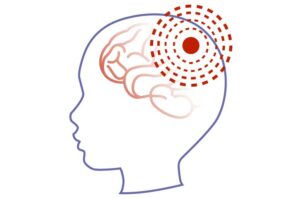What Is Hypoxic-Ischemic Encephalopathy (HIE)?
 HIE — sometimes called birth asphyxia — is a brain injury caused by a decrease in oxygen or blood flow to the brain. It is considered a life-threatening birth injury.
HIE — sometimes called birth asphyxia — is a brain injury caused by a decrease in oxygen or blood flow to the brain. It is considered a life-threatening birth injury.
The longer the baby’s brain goes without oxygen or blood flow, the more severe damage to the brain will be.
According to the American Medical Association, HIE is estimated to cause more than 1 million deaths worldwide each year.
“Children who experience HIE may have no long-term consequences. Some can have mild to moderate effects from HIE, while others can have more severe disability.”— Massachusetts General Hospital
Hypoxic-Ischemic Encephalopathy Symptoms
Hypoxic ischemic encephalopathy symptoms depend on how severe the brain damage is.
Some common HIE symptoms in newborns include:
- Abnormal movements
- Being overly tense and reactive to stimulation
- Breathing problems
- Heart, lung, or kidney problems
- High muscle tone (tight muscles)
- Low muscle tone (floppy muscle tone)
- Poor feeding
- Seizures
- Weak cry
The severity of brain damage is broken down into three hypoxic-ischemic encephalopathy stages. HIE stages are classified by the Sarnat staging scale, which categorizes HIE as mild, moderate, or severe.
Mild HIE Symptoms
Mild hypoxic ischemic encephalopathy symptoms usually resolve within 24 hours. However, even mild HIE symptoms should be taken very seriously. Whenever the brain doesn’t get enough oxygen, problems can arise.
According to the American Pediatric Society, mild HIE symptoms are increasingly being recognized as a warning sign of newborn brain injury. In fact, 37% of babies with mild HIE symptoms experience a detectable brain injury.
Mild HIE symptoms may include excessive crying, poor sleep or feeding, and irritability.
Moderate HIE Symptoms
Unfortunately, moderate HIE outcomes include 25-75% of babies being left with severe disabilities or possibly dying early in life.
Moderate HIE symptoms include:
- Extended pauses between breaths (apnea)
- Extreme tiredness
- Muscle weakness
- Poor reflexes, such as grasping and sucking
- Seizures within 24 hours of birth
Moderate hypoxic-ischemic encephalopathy symptoms can be warning signs that long-term issues will occur. This often leaves new parents wondering: Can babies with moderate HIE live a normal life?
If you have questions about whether your child’s HIE symptoms could mean they are at risk for future problems, talk with a registered nurse for free right now.
Severe HIE Symptoms
Severe HIE is the most serious type of infant brain damage. Sadly, the symptoms can be life-threatening, meaning that the baby’s severe HIE life expectancy may be greatly decreased.
Severe HIE symptoms include:
- Abnormal eye motion
- Breathing problems that require a breathing tube
- Coma
- Heart rate and blood pressure problems
- Lack of reflexes, such as grasping and sucking
- Seizures within the first few hours of birth
What is stage 3 hypoxic-ischemic encephalopathy? Also called severe HIE, 75% of babies with this condition will have severe disabilities.
How Do I Know If My Baby Has HIE?
For many families, HIE symptoms may be missed since all newborn babies behave differently in the hours following birth. However, it is important to understand that even without HIE symptoms, problems may still develop later in life.
HIE symptoms depend on the stage, which makes getting an accurate hypoxic-ischemic encephalopathy diagnosis especially important.
Our milestones quiz can help you determine if your child is experiencing developmental delays, which is one of the more common HIE symptoms.
IS YOUR CHILD MISSING DEVELOPMENTAL MILESTONES?
Take Our Milestones Quiz
Taking note of your child’s physical, social, and emotional skills can help you determine if they potentially suffered from an injury at birth. An early diagnosis can help your child get the treatment they need as soon as possible.
Q1: How old is your child?
0-2 MONTHS DEVELOPMENTAL MILESTONES QUIZ
- Q2: Can your child hold their head steadily on their own?
- Q3: Can your child push themselves up when they are lying on their stomach?
- Q4: Has your child started to make smoother movements with their arms and legs?
- Q5: Does your child smile at other people?
- Q6: Can your child bring their hands to their mouth?
- Q7: Does your child turn their head when they hear a noise?
- Q8: Does your child coo or make gurgling noises?
- Q9: Does your child follow things with their eyes?
- Q10: Does your child try to look at their parents or caregivers?
- Q11: Does your child show boredom, cry, or fuss when engaged in an activity that hasn’t changed in a while?


3-4 MONTHS DEVELOPMENTAL MILESTONES QUIZ
- Q2: Can your child hold their head steadily on their own?
- Q3: Does your child push down on their legs when their feet are on a flat surface?
- Q4: Has your child started to roll over from their stomach to their back?
- Q5: Can your child hold and shake a toy such as a rattle?
- Q6: Does your child bring their hands to their mouth?
- Q7: Does your child play with people and start to cry when the playing stops?
- Q8: Does your child smile spontaneously, especially at people?
- Q9: Does your child copy some movements and facial expressions of other people?
- Q10: Does your child babble with expressions and copy sounds they hear?
- Q11: Does your child cry in different ways to show hunger, pain, or tiredness?
- Q12: Does your child respond to affection like hugging or kissing?
- Q13: Does your child follow moving things with their eyes from side to side?
- Q14: Does your child recognize familiar people at a distance?


5-6 MONTHS DEVELOPMENTAL MILESTONES QUIZ
- Q2: Can your child roll over on both sides (front to back/back to front)?
- Q3: Has your child begun to sit without support?
- Q4: Does your child rock back and forth?
- Q5: Can your child support their weight on their legs (and perhaps bounce) when standing?
- Q6: Has your child begun to pass things from one hand to the other?
- Q7: Does your child bring objects such as toys to their mouth?
- Q8: Does your child know if someone is not familiar to them and is a stranger?
- Q9: Does your child respond to other people’s emotions, such as a smile or a frown?
- Q10: Does your child enjoy looking at themselves in the mirror?
- Q11: Does your child look at things around them?
- Q12: Does your child respond to sounds they hear by making sounds themselves?
- Q13: Does your child make sounds to show joy or displeasure?
- Q14: Does your child respond to their own name?
- Q15: Has your child started to string vowels together, such as "ah," "eh," or "oh," or started to say consonant sounds such as "m" or "b"?
- Q16: Has your child begun to laugh?


7-9 MONTHS DEVELOPMENTAL MILESTONES QUIZ
- Q2: Can your child crawl?
- Q3: Can your child stand while holding on to something to support them?
- Q4: Can your child sit without support?
- Q5: Can your child pull themselves up to stand?
- Q6: Does your child play peekaboo?
- Q7: Can your child move things from one hand to the other?
- Q8: Can your child pick small things up, such as a piece of cereal, with their thumb and index finger?
- Q9: Does your child look for things that they see you hide?
- Q10: Does your child watch the path of something as it falls?
- Q11: Does your child show fear when around strangers?
- Q12: Does your child become clingy with adults who are familiar to them?
- Q13: Does your child have favorite toys?
- Q14: Does your child use their fingers to point?
- Q15: Does your child understand “no”?
- Q16: Does your child make a lot of repetitive sounds, such as “mamama” or “bababa”?
- Q17: Does your child copy the sounds and gestures of other people?


10-12 MONTHS DEVELOPMENTAL MILESTONES QUIZ
- Q2: Can your child stand alone with no support?
- Q3: Does your child walk while holding on to furniture?
- Q4: Can your child take a few steps without holding on to anything?
- Q5: Can your child get into a sitting position without any help?
- Q6: Does your child bang two things together when playing?
- Q7: Does your child poke with their index finger?
- Q8: Has your child started to use things like hairbrushes or drinking cups correctly?
- Q9: Does your child find hidden objects easily?
- Q10: Does your child play peekaboo or pat-a-cake?
- Q11: Does your child become shy or nervous around strangers?
- Q12: Does your child repeat actions or sounds to get attention?
- Q13: Does your child put out an arm or leg to help when getting dressed?
- Q14: Does your child cry when a parent leaves the room?
- Q15: Does your child show that they have favorite things or people?
- Q16: Does your child show fear?
- Q17: Does your child say things such as “mama,” “dada,” or “uh-oh”?
- Q18: Does your child try to say the words you say?
- Q19: Has your child started to use gestures like waving or shaking their head “no”?


13-18 MONTHS DEVELOPMENTAL MILESTONES QUIZ
- Q2: Can your child walk by themselves?
- Q3: Does your child walk up stairs and run?
- Q4: Does your child pull toys while walking?
- Q5: Can your child drink from a cup on their own?
- Q6: Can your child eat with a spoon on their own?
- Q7: Can your child help undress themselves?
- Q8: Does your child have occasional temper tantrums?
- Q9: Does your child show affection to familiar people?
- Q10: Does your child become clingy in new situations?
- Q11: Does your child explore their environment alone with parents close by?
- Q12: Can your child say several single words?
- Q13: Can your child say and shake their head “no”?
- Q14: Does your child point to show things to other people?
- Q15: Does your child scribble?
- Q16: Does your child know what ordinary products such as phones, spoons, and brushes are used for?
- Q17: Can your child follow one-step commands such as “sit down” or “stand up”?
- Q18: Does your child play with a doll or stuffed animal by pretending to feed it?


19-23 MONTHS DEVELOPMENTAL MILESTONES QUIZ
- Q2: Has your child begun to run?
- Q3: Has your child kicked a ball?
- Q4: Can your child climb down and onto furniture on their own?
- Q5: Can your child walk up and down stairs while holding on?
- Q6: Can your child stand on their tiptoes?
- Q7: Has your child thrown a ball overhand?
- Q8: Does your child copy others, especially people older than them?
- Q9: Does your child get excited around other children?
- Q10: Has your child shown more independence as they've aged?
- Q11: Does your child do what they were told not to do and become defiant?
- Q12: Does your child point to things when they are named?
- Q13: Does your child know names of familiar people or body parts?
- Q14: Does your child say 2 to 4-word sentences?
- Q15: Does your child repeat words they hear?
- Q16: Does your child complete sentences and rhymes in familiar books?
- Q17: Does your child name items in books, such as dogs, cats, and birds?
- Q18: Does your child play simple pretend games?
- Q19: Has your child started to use one hand more than the other?
- Q20: Has your child begun to sort shapes and colors?
- Q21: Does your child follow 2-step instructions, such as “pick up your hat and put it on your head?”


24+ MONTHS DEVELOPMENTAL MILESTONES QUIZ
- Q2: Can your child run easily?
- Q3: Can your child climb?
- Q4: Can your child walk up and down stairs with one foot on each step?
- Q5: Can your child dress and undress themselves?
- Q6: Does your child show affection for friends without being told?
- Q7: Does your child take turns when playing games?
- Q8: Does your child show concern when others are crying?
- Q9: Does your child understand the idea of “mine" and "theirs"?
- Q10: Does your child show many different emotions?
- Q11: Does your child copy adults and friends?
- Q12: Does your child separate easily from their parents?
- Q13: Does your child get upset when there is a major change in their routine?
- Q14: Does your child say words such as “I,” “me,” “we,” “you,” and some plural nouns?
- Q15: Can your child say their first name, age, and gender?
- Q16: Can your child carry on a conversation with 2 to 3 sentences?
- Q17: Can your child work toys with buttons and other moving parts?
- Q18: Does your child play pretend with dolls, animals, or people?
- Q19: Can your child finish 3 or 4 piece puzzles?
- Q20: Can your child copy a circle when drawing?
- Q21: Can your child turn pages of a book one page at a time?
- Q22: Can your child turn door handles?


HIE Symptoms and Risk Factors Before Delivery
HIE symptoms before delivery usually involve signs of fetal distress, such as an increased heart rate or decreased movement in the womb.
Risk factors of HIE in pregnancy can include maternal high blood pressure (preeclampsia), problems with blood flow to the placenta, low red blood count (anemia) in the developing baby, or maternal diabetes with heart disease.
Symptoms of Hypoxic-Ischemic Encephalopathy in Newborn Babies
HIE symptoms in babies can be the result of issues that occur during labor or delivery, umbilical cord problems, or uterine rupture. All of these cause a lack of oxygen or blood flow to the infant.
Signs of HIE in newborn babies include:
- Abnormal muscle tone (low or high)
- Breathing problems
- Impairment in reflex responses (reflexes are used to evaluate neurological health)
- Low Apgar score (test used to evaluate a newborn’s breathing, heart rate, muscle tone, reflexes, and skin color)
- Low blood pressure
HIE Symptoms in Childhood
The symptoms of hypoxic-ischemic encephalopathy are not always spotted right away. In some cases, developmental delays and neurological problems aren’t noticeable until the child grows older.
HIE symptoms in toddlers and children may include:
- Cognitive impairment (difficulty remembering things)
- Epilepsy (seizure disorder)
- Heart, kidney, liver, or lung problems
- Moodiness or behavioral issues
- Organ failure
- Poor coordination
- Seizures
- Strange eye movements or vision problems
Hypoxic-Ischemic Encephalopathy Life Expectancy
HIE baby life expectancy depends on how severe the brain damage is. Many babies with this condition make a full HIE recovery. However, any time the brain’s blood or oxygen supply is cut off, there is a risk of long-term complications.
Usually, the length of time the brain is deprived of oxygen determines the severity of brain damage. Severe HIE can cause serious conditions such as cerebral palsy, seizures, vision loss, and even organ failure.


Compensation awarded from a birth injury lawsuit can help provide the financial security you need to properly care for your child throughout their lifetime.
HIE Symptoms & Medical Malpractice
Mild hypoxic-ischemic encephalopathy symptoms usually resolve within 24 hours. However, moderate or severe HIE symptoms can indicate a lifetime of challenges for your family.
If you believe your child’s HIE symptoms are the result of medical malpractice, we may be able to help.
Examples of HIE causes related to medical malpractice include:
- Failing to properly respond to fetal distress
- Failing to provide cooling therapy to an HIE baby
- Misreading fetal heart monitors
- Neglecting to identify maternal risk factors, such as diabetes
- Overusing delivery-inducing medications, such as oxytocin (Pitocin®)
- Poor prenatal care, especially in a high-risk pregnancy
Get a confidential and free consultation now to find out if you are eligible. Call (800) 914-1562 or fill out our free case review form to receive a callback.
HIE Symptoms FAQs
What causes hypoxic ischemic encephalopathy?
HIE is caused by a lack of oxygen or blood flow to the brain. This can occur due to issues that arise at any time from pregnancy until after a baby is born. Some common HIE causes include preeclampsia (a condition involving maternal high pressure during pregnancy and a risk for seizures), umbilical cord accidents, or severe prematurity.
How is hypoxic encephalopathy diagnosed?
HIE is diagnosed by monitoring a baby for signs of fetal distress, seizures, and brain dysfunction. Diagnostic tests may also be conducted.
HIE diagnostic tests may include blood tests, electroencephalograms (EEGs), ultrasounds, computed tomography (CT) scans, and magnetic resonance imaging (MRI) scans. These tests provide imaging of the brain to evaluate the brain’s activity.
What are the three stages of HIE?
The three stages of hypoxic-ischemic encephalopathy are mild HIE, moderate HIE, and severe HIE.
Hypoxic-ischemic encephalopathy stages depend upon the severity of brain damage, which is usually determined by how long the brain went without oxygen or blood flow. It can also be determined by which part of the brain was affected.
What does mild HIE look like?
Mild HIE symptoms include more crying than normal, poor sleep, irritability, and poor feeding. Symptoms of mild hypoxic-ischemic encephalopathy usually resolve on their own within 24 hours.
Is hypoxic encephalopathy curable?
No. HIE is not curable, but its effects may be able to be reduced with treatments such as cooling therapy.
The treatment for HIE depends on its severity and may involve physical, occupational, and speech therapy; medications to control seizures; and oxygen therapy to help with breathing problems.
How long do children with HIE live?
HIE baby life expectancy will likely be normal in mild HIE cases. However, babies with moderate or severe HIE are at a higher risk of early death. This risk is especially great if the baby has severe organ damage caused by their HIE.
Can HIE be missed?
Yes. Sometimes, mild HIE symptoms can go unnoticed, especially if they resolve within 24 hours. Alarmingly, even when obvious hypoxic ischemic encephalopathy symptoms are present, they can be ignored. This could happen if medical malpractice comes into play, as health care providers may try to downplay or even hide their mistakes.






